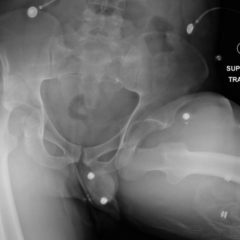Bedside Ultrasound for the Diagnosis of Peritonsillar Abscess
History of present illness:
A 34-year-old male presented to the emergency department with fever, sore throat, and difficulty swallowing. On exam, the patient had trismus, a deviated uvula, and swelling of his left peritonsillar space. An intraoral point of care ultrasound (POCUS) was performed, which revealed a fluid collection in the patient’s left peritonsillar space. The patient was diagnosed with a peritonsillar abscess (PTA) and needle aspiration was performed under direct ultrasound guidance. The patient tolerated the procedure well and was sent home with a course of antibiotics.
Significant findings:
The first video is an intraoral ultrasound using the high frequency endocavitary probe demonstrating an anechoic fluid collection adjacent to the patient’s enlarged left tonsil. The second video shows real-time ultrasound-guided successful drainage of the PTA.
Discussion:
Peritonsillar abscesses are the most common deep space infection of the head and neck1, most commonly affecting children and young adults.2 The ability of physicians to accurately differentiate PTA from peritonsillar cellulitis (PTC) by physical exam alone is limited. Traditionally, PTA has been treated using landmark-based needle aspiration.3 If unsuccessful, computed tomography (CT) imaging and otolaryngology (ENT) consultation is usually required.3 Although diagnosis of PTA using intraoral ultrasound has a sensitivity and specificity of between 89%-95% and 79%-100% respectively, it is still underutilized in comparison to these traditional methods.4 Studies have shown the use of ultrasound for diagnosis and treatment of PTA leads to significantly better outcomes and higher success rates of drainage (when compared to landmark-based needle aspiration), less need for CT imaging, and less need for ENT consultation.3 Utilizing intraoral point-of-care ultrasound is an efficient, safe, and cost-effective way of diagnosing and treating PTA.
Topics:
Peritonsillar abscess, intraoral ultrasound, head and neck, point of care ultrasound, ENT.
References:
- Galioto NJ. Peritonsillar abscess. Am Fam Physician. 2017;95(8):501-506.
- Schraff S, McGinn JD, Derkay CS. Peritonsillar abscess in children: a 10-year review of diagnosis and management. Int J Pediatr Otorhinolaryngol. 2001;57(3):213-218. doi: 10.1016/S0165-5876(00)00447-X
- Costantino TG, Satz WA, Dehnkamp W, Goett H. Randomized trial comparing intraoral ultrasound to landmark-based needle aspiration in patients with suspected peritonsillar abscess. Acad Emerg Med. 2012;19(6):626-631. doi: 10.1111/j.1553-2712.2012.01380.x
- Powell J and Wilson JA. An evidence-based review of peritonsillar abscess. Clin Otolaryngol. 2012;37(2):136-145. doi: 10.1111/j.1749-4486.2012.02452.x

